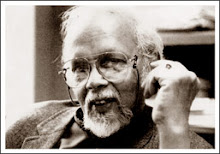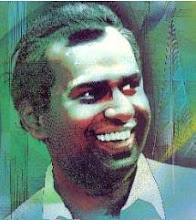|
|
A great deal has already been written about Prof. Ediriweera Sarachchandra, yet to my knowledge hardly anything has been written about the three years he spent in Paris (France) as the Ambassador of Sri Lanka. This note is meant to fill this gap.
It's well known that Prof. Sarachchandra played a key role in the election campaign against the UNP Government in 1970. Though generally apolitical, Prof. Sarachchandra was drawn into it by his staunch opposition to the draconian measures against university autonomy proposed by the regime.
As an independent thinker Prof. Sarachchandra was also opposed to certain measures taken by the coalition government, particularly after the 1971 insurgency. Sarachchandra had been unanimously nominated as the chairman of the Civil Rights Movement established on 18th Nov. 1971. This I guess would have been yet another reason why Prof. Sarachchandra was considered for a diplomatic appointment by the Sirimavo Bandaranaike government.
In an interview in 1996, this is how the late professor described the dilemma he had to face: "I supported the coalition because I thought the politics of the left together with the left of centre politics of the SLFP will offer a good balance. But later on I was beginning to get critical of the government.
I headed the Civl Rights Movement which was formed to monitor violations of civil rights, specially after the 71 insurrection. When I was critical of the government, they probably wanted me out of the way - so they offered me this job, which was very difficult for me to refuse anyway as I was badly in need of the money."
By this time Prof. Sarchchandra was on the verge of retirement. He had devoted his entire life to creative and academic work within the university. Yet, it seemed that the truth of the age old Indian diction (Sarasaviya ha sirikatha eka thena nowasathi) Goddess Saraswathi and the Goddess of prosperity do not go together was beginning to dawn on him.
He never owned a house that he could call his own even at retirement. He never pocketed a cent of the charges that came from the performances of the plays he produced for the 'Sinhala natya sangamaya' of the university of Peradeniya.
When it came to the second production of 'Sinhabahu' in 1971, he had to turn to his friends for the required sum of rupees 7500. Part of that money was provided by me. (I must record here that this money was duly returned to me within one year - see Sinhabahu brochure 1972).
I went to Paris on an invitation by Prof. Sarachchandra in December 1976. It was the thick of winter in Europe. As I stepped into the official residence he welcomed me with a familiar smile and wittily quipped, 'Gala! What a great distance have you come to see for yourself a modicum of suffering and pain'.
smile and wittily quipped, 'Gala! What a great distance have you come to see for yourself a modicum of suffering and pain'.
The official residence of the Sri Lankan Ambassador was located at Neuilly Sur Saine, a picturesque suburb of Paris, surrounded by multi-storeyed apartments and dotted here and there by luxurious residences of multi million. It was really an ideal residential area.
I well remember hearing that one of the world's richest men Aristotal Onasis owned a mansion in that area. In this picturesque setting, I must say, the building of the Sri Lankan Ambassador's residence was probably the ugliest, gloomiest and dirtiest of the whole of Rue Perronet.
There was a dilapidated stable in that small compound of four to five perches. This box-shaped three storeyed building was surrounded by a high wall which seemed not to have seen any paint for an uncountable number of years. Hence it was dark in patches and covered with moss here and there. The carpets inside were not much better.
They were both old and worn out. The wall papers around had well forgotten their original colours. The electricity circuit within the house was dangerously fragile. When we think of Paris as a global trend-settler of fashions and elegant living the world over the Sri Lankan Ambassadors' residence would not have brought a respect for Sri Lanka, though it may well have degraded our image abroad.
Prof. Sarachchandra recorded his embarrassment thus "The residence of the Ambassador is in the fashionable Neuilly-Sur-Seine area, but it is one of the most disreputable looking buildings in that area.
Its roof is on the point of crumbling down, its outer walls are dirty and haven't been cleaned in the past 10 years since we began to rent out the house, its floors need carpeting and its inner walls and wood work need painting and redoing. I have felt ashamed to invite Ambassadors to my house because of its state of neglect. If felt ashamed of course, on behalf of the country I was representing. Actually, we have not had the means to maintain the house decently."
Further on the same subject he says; "It's not a question of poverty. Countries do not establish diplomatic missions in order to advertise their poverty. Vulgar ostentation is, of course, not appropriate, but certain standards have to be maintained. Poorer countries like Bangladesh keep up a more decent level and entertain better, and I'm sure that they find it more profitable in the long run.
My point is that it would be more in keeping with our national self-respect to close down missions that can't be maintained at decent levels and to put such resources to improve the missions that are left and which we feel are useful to maintain". (The Sunday Observer, November 13-1977).
Once I remember how a member of our diplomatic mission was hotly contradicted when he introduced a brass lamp with an engraved figure on top, as an authentic Sri Lankan creation. The knowledgeable foreigner traced its Indian origin. This simple incident exposes the ignorance of our officials who are attached to our missions abroad.
I would now like to illustrate how Sarachchandra the artist live inside Sarachchandra the diplomat in Paris. Sarachchandra did not forget to take his sitar when he went to Paris. Whenever he had some free time he would play the sitar in trance-like meditation.
He even hired a music teacher to improve his Kills. This person happened to be a Nepalese and was totally blind. He lived in Paris giving brief recitals on TV and visited us each Wednesday.
It was quite touching to see how Prof. Sarachchandra welcomed his teacher at the door-step and then offer him a warm cup of tea by his own hands. He would practise what he has learned until late into the night.
Sarachchandra used to get down publications of creative literature from home and read them very carefully, keeping abreast of every development in Sri Lanka. It was during the same period that he edited a translation of 'Pematho Jayathi Soko' rendered in to English by Derik de Silva who happened to be attached to Oxford University at that time.
This text was included in series of play scripts representing contemporary world theatre published by Salsburg University, Austria. His English novel titled "With the begging bowl" was based on his experience as the ambassador, and was later published in India. Inthe same period I could also see how happy he was to train a group of Sri Lankans in Paris to sing Bhakthi Gee at Vesak. He probably felt the need to create a Sri Lankan cultural environment around himself.
I feel it would be inappropriate to end this note without reference to the memories of our long walks on the bank of the river Seine. Most often, we set out from Rue perronat where the Ambassador's residence was located, along narrow paths leading to Sein, crossing Boulevard de Chateau.
We walked up to the Boulevard de General lecturer. Here one could see a few small islands (Il Dela Gon Jeane) in the middle of the river Seine, and the water of the river divide into two steams. As the evening deepened we would see holiday makers pass by in their boats studded with lights, playing sweet melodies as they melted into the distant mist.
The highrise buildings on the Courbevie area on the other side of the bank would light up plunging the reflected light deep into the water of the calm river giving it another worldly charm. This is said to be an industrial area, well described in Gue de Maupassants' stories.
As we walk along we would meet retired French couples arm in arm walk along with their extravagantly attired pet dogs. Our conversation would drift from talk about old age life-family bonds-cultural values, East and West ..... and so on. In one of these walks, professor told me how he got the title for his novel based on the 1971 insurgency (Heta Ehchara Kaluwara Ne) from a Parisian advertisement which read 'Il ne par is noir demain".
With the defeat of the Sirimavo Bandaranaike Government in 1977, Prof. Sarachchandra promptly returned to Sri Lanka and once again left the island on an appointment as a research professor at the East-West Centre, Hawaii.
There was hardly anything Prof. Sarachchandra earn from his post as Ambassador in Paris. Part of his personnel salary too was sometimes channelled to safeguard the image of our country. Unlike many diplomats who return home with a plethora of foreign gadgets, foreign furniture, cars, washing machines and what not and anxiously wait for the next posting abroad, Sarachchandra returned to his old residence at Epitamulle, Pitakotte. Since he had no vehicle of his own to get about I had to lend my old 4 Sri Volkswagen until the day he left for Hawaii (USA).
(The writer is former Deputy Principal of St. Anthony's College, Kandy and author of several publications both Sinhala and English).





































would one of your educated s tell me beauty and the beast tv series is a maname drama`s English west version or not?
ReplyDelete